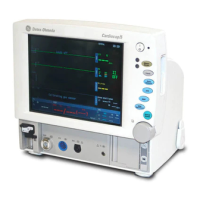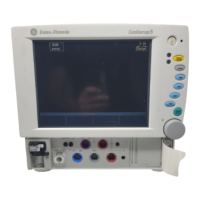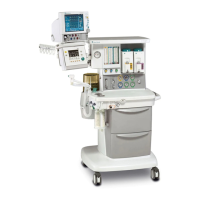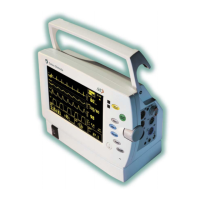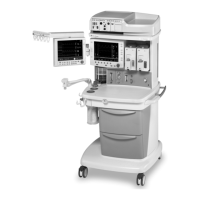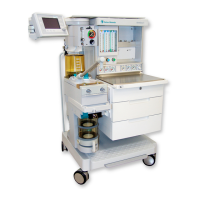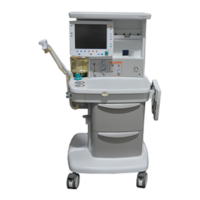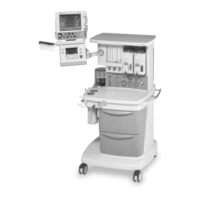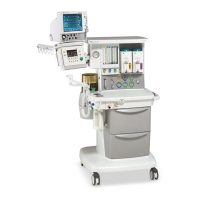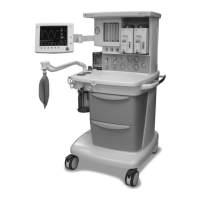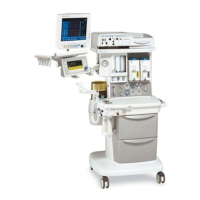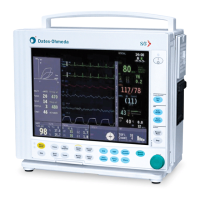Do you have a question about the Datex-Ohmeda CARESCAPE R860 and is the answer not in the manual?
Provides a general overview of the GE Healthcare CARESCAPE R860 ventilator and its features.
Details the intended use of the CARESCAPE R860 ventilator for neonatal, pediatric, and adult patients.
Lists any known contraindications for the use of the ventilator.
Provides instructions for the proper operation of the ventilator by trained medical personnel.
Lists registered trademarks of General Electric Company and other product names.
Explains the coded logic in Datex-Ohmeda product serial numbers for identification.
Provides an overview of the CARESCAPE R860's features, capabilities, and supported patient types.
Locates the specific section for neonatal ventilation within the manual.
Lists abbreviations used in the manual with their definitions.
Explains symbols used on equipment, user interface, packaging, and safety/manual terms.
Describes the 15-inch touchscreen display, keypad, and Trim Knob control.
Details the components and layout of the user interface.
Explains how to navigate and adjust active alarms through the interface.
Describes the standby mode and its functions upon system startup or selection.
Explains how to access ventilator features and options via the main menu.
Details settings for data source, calibration, display brightness, and system information.
Guides the user on how to change settings using the Trim Knob.
Explains how to navigate between different workspaces and views.
Describes the views available in the Present/Patient Status workspace.
Details the views for reviewing historical trends of patient data.
Describes views for clinical decision support features like SBT, FRC, and Spirometry.
Outlines essential safety precautions and warnings for ventilator setup and operation.
Identifies and describes the components visible on the front of the ventilator.
Identifies and describes the connections and components on the back of the ventilator.
Provides instructions on how to connect the power cord and turn on the ventilator.
Details how to connect the O2 and air supply connections to the ventilator.
Explains how to connect the exhalation valve heater cable to prevent moisture condensation.
Guides the user on installing and connecting the accessory rail to the ventilator cart.
Provides instructions and warnings for connecting the breathing circuit to the ventilator.
Explains how to connect the water trap to the breathing circuit.
Details the connection of a HME to the breathing circuit.
Provides instructions for connecting the GE Healthcare recommended humidifier.
Explains how to connect the Aerogen Professional Nebulizer System.
Describes the function and types of airway modules.
Guides on attaching and connecting the airway module and module bay.
Provides instructions for connecting the Pedi-lite(+) and D-lite(+) sensors.
Explains the procedure for calibrating the airway module.
Details how to connect and position the support arm.
Provides instructions on how to safely remove the display unit.
Guides on installing the display unit onto a rail system.
Provides instructions for mounting the display unit onto the ventilator.
Explains how to connect the auxiliary pressure tubing.
Details the steps to purge the auxiliary pressure tubing.
Explains how to connect the EVair compressor to the ventilator.
Provides instructions for connecting the nurse call system.
Details how to connect communication ports for data transfer.
Explains how to connect the ventilator to the facility IT Network.
Provides guidance on connecting isolated electrical outlets.
Explains invasive and non-invasive ventilation, and mechanical vs. spontaneous breaths.
Details the four categories of ventilation mode settings and quick key access.
Describes how tube compensation addresses airway resistance.
Explains how assist control synchronizes mechanical breaths with patient efforts.
Details how the ventilator adjusts for exhaled volume differences due to leaks.
Explains how trigger compensation adjusts flow trigger to prevent auto-triggering.
Describes how backup mode is entered based on ventilation insufficiency.
Details the A/C VC mode, including breath delivery and settings.
Explains the A/C PC mode, breath delivery, and available settings.
Describes the A/C PRVC mode, including pressure adjustment and settings.
Details the SIMV VC mode, including breath delivery and settings.
Explains the SIMV PC mode, breath delivery, and settings.
Describes the SIMV PRVC mode, including pressure adjustment and settings.
Details the CPAP/PS mode for spontaneously breathing patients.
Explains the BiLevel mode, including pressure alternation and spontaneous breathing.
Describes the BiLevel VG mode, including pressure support and tidal volume delivery.
Explains the APRV mode with high and low pressure levels.
Details the VS mode for spontaneously breathing patients, supporting tidal volume delivery.
Describes the NIV mode for spontaneously breathing patients.
Explains the SBT mode for evaluating a patient's ability to breathe spontaneously.
Covers turning the ventilator on and off, including startup tests and messages.
Instructions for preparing the ventilator for a new patient or selecting a previous patient.
Details the System Check overview, circuit setup, and running the check.
Explains setting the ventilator data source and system menu for patient ventilation.
Guides on selecting and confirming ventilation and backup modes.
Provides steps for starting patient ventilation after system checks.
Explains how to pause ventilation and the implications of standby mode.
Describes how to select and assign up to four favorite procedures for quick access.
Details the open suction procedure, including oxygenation and standby phases.
Explains the use of Aerogen nebulizers for aerosolized medication delivery.
Describes how the ventilator compensates for external pneumatic nebulizers.
Guides on increasing oxygen delivery to prevent low oxygen saturation levels.
Explains the procedure for determining plateau pressure and static compliance.
Describes the procedure to measure end breath lung pressure.
Allows the clinician to deliver additional mechanical breaths to the patient.
Details the respiratory measurement to evaluate patient readiness for weaning.
Explains NIF measurement to assess patient's ability to breathe and clear secretions.
Describes the measurement of a patient's largest expired Tidal Volume.
Explains measurement of pressure remaining in lungs above PEEP value.
Provides information on attending to patients during alarms and repair policies.
Explains how alarms are managed from the alarm bar for priority and settings.
Describes the visual indication of parameter and technical alarms in the alarm bar.
Details how to adjust alarm limits and other alarm settings.
Explains how to set auto alarm limits based on current measured data.
Describes audible and visual indicators that tell the priority of an alarm.
Explains how to temporarily mute audible alarm tones for two minutes.
Describes the backup audio alarm functionality.
Explains how measured data alarms are displayed and adjusted.
Provides a comprehensive list of alarms, their causes, and actions.
Explains how similar alarms can be filtered or removed from the alarm list.
Lists alarms and their associated delays upon specific events.
Provides procedures for testing various alarm systems.
Tests the low O2 alarm functionality.
Tests the high O2 alarm functionality.
Tests the low EtO2 alarm functionality.
Tests the high EtO2 alarm functionality.
Tests the low EtCO2 alarm functionality.
Tests the high EtCO2 alarm functionality.
Tests the low PEEPe alarm functionality.
Tests the high PEEPe alarm functionality.
Tests the low VTexp alarm functionality.
Tests the high VTexp alarm functionality.
Tests the Pmax alarm functionality.
Tests the low O2 supply pressure alarm.
Tests the low air supply pressure alarm.
Tests the sustained airway pressure alarm.
Tests the minute volume alarm functionality.
Tests the breathing circuit occlusion alarm.
Tests the breathing circuit alarm for leaks.
Tests the apnea alarm functionality.
Tests the patient disconnected alarm.
Tests the alarm for a disconnected nebulizer.
Tests the low internal battery alarms at various time thresholds.
Tests the power failure alarm and battery status indicators.
Lists potential internal hardware or software errors and troubleshooting steps.
Provides solutions for common problems with the ventilator.
Offers troubleshooting steps specifically for Non-Invasive Ventilation modes.
Lists general messages, notices, and status information shown to the user.
Explains patient monitoring views and measured data.
Defines gases, pulmonary, mechanical/spontaneous, per weight, and spirometry data.
Details how to configure waveform settings like style, speed, color, and scaling.
Guides on configuring spirometry loops and settings.
Explains how to interpret waveforms and their components.
Describes how to read and interpret spirometry loops.
Notes that airway module trend data is unavailable for neonatal patients.
Explains how to use the Trends workspace to view patient data trends.
Describes how to view plotted data for a selected period on the timeline.
Details the Mode, Measured, and Alarms tabs for numerical trends.
Shows a list of alarms and events that occurred during the selected period.
Explains how to view saved data at selected times within the past 72 hours.
Monitors patient breathing with Pressure Support for a set period.
Evaluates patient data after or during a spontaneous breathing trial.
Guides on transitioning from ventilation to SBT and setting criteria.
Explains how to measure FRC in adult and pediatric patients.
Outlines requirements for performing FRC and PEEP INview procedures.
Details how to perform FRC INview as a single or series procedure.
Explains how to evaluate PEEP value effects on FRC.
Combines PEEP INview with SpiroDynamics for enhanced lung function view.
Describes the Evaluate, FRC INview, and PEEP INview tabs.
Shows spirometry loops and measured data, with Spirometry and SpiroDynamics tabs.
Details SpiroDynamics tab features, including loops and measured data.
Guides on setting up and viewing SpiroDynamics data.
Shows measured data trends and values related to patient metabolics.
Explains requirements for accurate metabolic data obtained during steady state.
Provides steps to prepare for steady state ventilation for metabolic studies.
Guides on reviewing Metabolics trends data.
Shows calculated data based on ventilator and lab blood gas data.
Details how to set and confirm input data for blood gas values.
Shows the data entered under Lab Data.
Presents calculations based on blood gas data and ventilator data.
Shows calculations based on blood gas data and ventilator data.
Use to set facility and system defaults per patient type.
Set facility default settings for each patient type.
Supports Calibration, Service, and Service Log menus.
Outlines service policies, exceptions, and authorized service requirements.
Recommends scheduled maintenance checks by authorized service representatives.
Advises keeping the ventilator connected to main power to prevent battery issues.
Instructs on proper disposal of the ventilator and accessories.
Shows data used for maintenance and service, including software and airway module data.
Details the procedure to test battery capacity and replacement criteria.
Lists minimum maintenance intervals recommended by GE Healthcare.
Calibrates the system when performance is questionable or components are replaced.
Provides maintenance guidelines for airway modules, including calibration.
Details preventative maintenance for the compressor.
Indicates minimum recommended maintenance and reprocessing cycles for components.
Shows compatibility of component materials with reprocessing agents.
Details compatibility of external surfaces with reprocessing agents.
Provides instructions for cleaning display and ventilator fan filters.
Explains how to locate and replace the compressor filter.
States that cleaning and sterilization instructions are validated for device reuse.
Recommends processing ventilator components between patients.
Explains that the inspiratory safety guard cannot be cleaned and when to replace it.
Provides instructions for disassembling assemblies prior to processing.
Instructions for removing the neonatal flow sensor.
Provides instructions for re-assembly or use of Pedi-lite(+) or D-lite(+) sensors.
Details how to remove and reassemble the expiratory flow sensor.
Provides instructions for removing the exhalation valve assembly.
Explains how to disconnect and empty the water trap assembly.
Details the soaking method for cleaning various parts.
Provides manual soaking methods for disinfection using hydrogen peroxide or ortho-phthaldehyde.
Explains automated cleaning and disinfection using specific washer cycles.
Provides guidelines for sterilizing nebulizer components using an autoclave.
Provides cleaning, disinfection, and sterilization instructions for Aerogen Pro Nebulizer.
Instructions to disassemble the nebulizer before processing.
Details cleaning the nebulizer unit, T-pieces, and adapters.
Lists approved disinfection solutions for the Aerogen Pro Nebulization System.
Explains automated washing cycles for nebulizer components.
Provides methods for steam sterilization of nebulizer components.
Contains general ventilator specification information.
Lists approximate physical dimensions and weights of the ventilator with and without a cart.
Specifies the volume measurements of auditory alarm signals in dB.
Details thermal, humidity, barometric pressure, sound pressure, and sound power specifications.
Lists pneumatic specifications for the CARESCAPE R860 ventilator.
Provides specifications for supply voltage, power consumption, and fuses.
Details the ventilator's battery operation and types.
Explains the battery icons and their meaning regarding power source and remaining time.
Tests the low internal battery alarms at various time thresholds.
Details the procedure to test battery capacity and replacement criteria.
Explains the use of the equipotential stud for grounding the system.
Shows ventilation settings with available range and resolution for adult patients.
Provides gas specifications for E-series and CARESCAPE airway modules.
Details the ventilator's compliance with EMC regulations.
Provides precautions to avoid electrical shock and ensure safety.
Outlines the classification of the ventilator and accessories according to IEC 60601-1.
Explains FRC and its relationship to PEEP settings and ventilation opportunities.
Describes the FRC measurement process using nitrogen washout.
Provides analysis for Indirect Calorimetry to measure caloric needs and metabolic status.
Explains how the ventilator calculates instantaneous leak compensation rate.
Details gas exchange measurements and their clinical applications.
Explains how airway modules monitor O2 consumption, CO2 production, and RQ.
Describes measurements like static plateau pressure and static compliance.
Provides guidance on interpreting airway module data for accuracy.
Explains indirect calorimetry measurement of oxygen uptake by tissues.
Details VCO2 measurement susceptibility to errors and the Bohr's equation.
Defines RQ as the ratio between VCO2 and VO2 in steady state conditions.
Explains how energy expenditure is calculated from gas exchange variables.
Describes the test method for determining respiration rate range and gas reading accuracy.
Explains how patient weight affects the suggested VT setting.
Provides the formula for estimating BSA in adult and pediatric patients.
Outlines the estimation of IBW for adult, pediatric, and neonatal patients.
Describes the system as a software-controlled product receiving clinical inputs.
Details the major processor control boards and electronic architecture.
Explains the pneumatic architecture and operation of the ventilator.
Lists replacement parts and accessories validated for use with the CARESCAPE R860.
Lists various system accessories with their corresponding part numbers.
Identifies key system parts with their corresponding part numbers.
Provides information on power cord configurations.
Lists descriptions and part numbers for various airway modules.
Details the components and part numbers for the exhalation valve assembly.
Lists the part number for the exhalation valve heater and its cable.
Introduces the neonatal option and features for neonatal patients.
Directs users to the specific neonatal section within the manual.
Highlights safety precautions specific to neonatal use.
Provides instructions for connecting the neonatal flow sensor.
Explains invasive and non-invasive ventilation, and mechanical vs. spontaneous breaths.
Details features for assist control, leak compensation, trigger compensation, and backup mode.
Explains how assist control synchronizes mechanical breaths with patient efforts.
Details how the ventilator adjusts for exhaled volume differences due to leaks.
Explains how trigger compensation adjusts flow trigger to prevent auto-triggering.
Describes how backup mode is entered based on ventilation insufficiency.
Details the nCPAP mode for non-invasive ventilation of neonatal patients.
Lists the available invasive ventilation modes for neonatal patients.
Covers turning the ventilator on and off for neonatal operation.
Instructions for preparing the ventilator for a new neonatal patient.
Details the System Check overview for neonatal patients.
Explains setting the ventilator data source for neonatal patients.
Guides on selecting and confirming ventilation and backup modes for neonatal patients.
Provides steps for starting patient ventilation after system checks for neonatal patients.
Describes the standby mode for neonatal operation.
Explains how to change ventilation modes and settings.
Describes how to select favorite procedures for neonatal patients.
Details the open suction procedure for neonatal patients.
Explains nebulizer treatment for neonatal patients.
Describes pneumatic nebulizer compensation for neonatal patients.
Guides on increasing oxygen delivery for neonatal patients.
Provides neonatal alarm information and repair policies.
Explains alarm management for neonatal alarms.
Lists neonatal alarms, their causes, and actions.
Describes battery status icons and alarms for neonatal patients.
Lists internal errors and troubleshooting for neonatal patients.
Provides common troubleshooting solutions for neonatal issues.
Offers troubleshooting steps for nCPAP mode.
Lists general messages displayed for neonatal patients.
Explains patient monitoring views and neonatal measured data definitions.
Details how to configure waveform settings for neonatal patients.
Guides on configuring spirometry loops for neonatal patients.
Explains how to interpret waveforms for neonatal patients.
Describes how to read and interpret spirometry loops for neonatal patients.
Notes that airway module trend data is unavailable for neonatal patients.
Monitors patient breathing with Pressure Support for SBT in neonatal patients.
Evaluates patient data after or during SBT for neonatal patients.
Shows spirometry loops and measured data for patient lung function evaluation.
Provides instructions for removing the neonatal flow sensor.
Details cleaning and calibration procedures for the neonatal flow sensor.
Guides on automatically calibrating the neonatal flow sensor via System Check.
Contains general ventilator specification information for neonatal patients.
Shows ventilation settings with available range and resolution for neonatal patients.
Shows the range for each neonatal parameter alarm and factory default.
Details the type of filtering used when showing waveforms.
Specifies accuracy and response time for neonatal tidal volume delivery.
Provides values for invasive pressure control ventilation modes.
Provides values for invasive pressure control ventilation modes.
Specifies mixture accuracy measured at the inspiratory port.
Represents ventilator breathing system compliance and resistance ranges for neonatal patients.
Details monitoring measurements, range, resolution, and accuracy.
Lists replacement parts and accessories validated for the CARESCAPE R860.
Explains that the inspiratory safety guard cannot be cleaned and when to replace it.
Lists the part numbers for the neonatal flow sensor and its cable.
| Device Type | Ventilator |
|---|---|
| Model | CARESCAPE R860 |
| Category | Medical Equipment |
| Manufacturer | Datex-Ohmeda (GE Healthcare) |
| Ventilation Modes | Volume Control, Pressure Control, SIMV, Pressure Support, CPAP |
| Patient Type | Adult, Pediatric, Neonatal |
| Display | Touchscreen |
| Power Source | AC Power, Battery |
| Connectivity | Ethernet, USB, Serial |
| Humidification | Integrated Humidifier |
| Battery Life | Up to 2 hours (internal battery) |
| Respiratory Rate | 1 - 150 breaths per minute |
| FiO2 Range | 21% to 100% |
| O2 Supply Pressure | 34 - 87 psi (2.3 - 6 bar) |
| Air Supply Pressure | 34 - 87 psi (2.3 - 6 bar) |
| Inspiratory Time | 0.1 - 5 seconds |
